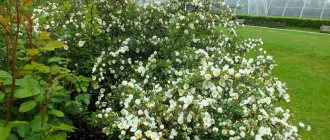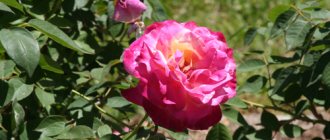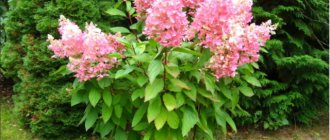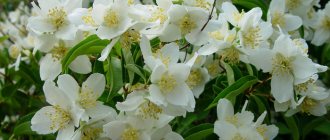European varieties of roses are highly valued by Russian flower growers. This happened mainly because the varieties of ornamental flowering plants bred in the countries of the Old World are more adapted to our latitudes due to their high resistance to cold. However, one should not ignore the creations of breeders working on other continents. For example, the John Davis variety also has something to surprise you.
Description of the John Davis rose variety and characteristics
It is a shrub with long climbing shoots. The height of John Davis roses reaches 2 m. The plant quickly grows in width - up to 2.5 m.
Annual growth of bushes – up to 40 cm
In the first 1-2 years, the shoots are short and erect, which is why the John Davis rose looks like a standard one. Subsequently, the stems begin to bend towards the ground. To maintain the neat shape of the bush, a garter to the trellis is required.
The shoots are strong, elastic with dark green bark, and are not prone to lignification. There are practically no large thorns on the stems. The foliage is dense, lush, along the entire length of the shoots. The plates are oval, 5-6 cm long, with jagged edges. The leaves are matte, rich green.
The budding period begins in mid-to-late May and continues throughout June. The John Davis variety begins to bloom in the first month of summer. The buds open quickly and gradually fade by mid-July.
The plant blooms very profusely, continuously. Inflorescences of 10-15 buds are formed on the stems. The flowers are densely double, round, hemispherical in shape, with 50-60 petals. Color – bright pink. The aroma is pleasant, strongly pronounced even from a distance.
John Davis rose flowers fade in the sun and turn ashen
Important! Due to its sensitivity to light, it is recommended to plant the variety in partial shade.
The John Davis variety is characterized by high cold resistance. The plant tolerates frosts down to -29 degrees. In the south and regions of central Russia, there is no need to cover bushes for the winter. Such measures are necessary only in Siberia and the Urals, where the temperature in winter is constantly negative.
John Davis rose bushes remain decorative until mid-autumn. In October, the foliage on the bushes begins to fade, resulting in bare stems.
The variety does not tolerate drought well. This is explained by the large number of leaves, which quickly evaporate moisture in the summer. Overwatering can also harm bushes, especially when soil compacts near the roots.
John Davis roses are disease resistant. The risk of developing powdery mildew and black spot exists only with high humidity or during drought.
Rose blossom
Rose Cuthbert Grant from the Marshall collection
Period of activity and rest. The rose bush begins to bloom a little earlier than its relatives, from the beginning of the first month of summer until the end of August. In August, flowering is no longer so abundant, but the buds on the branches become larger, pale pink, with a beige tint, until October.
Bloom
Care during and after flowering
There are recommendations for caring for the plant:
- abundant watering is the main care during the flowering period, in dry weather, about three times a week, flooding the soil up to half a meter deep. The ideal time for watering is in the evening, the water penetrates deeply into the ground without evaporating;
- Several times a season it is worth spraying the plant with special solutions containing insecticide and fungicide. This procedure will protect the rose bush from harmful annoying insects and prevent the occurrence of fungal diseases.
What to do if it doesn't bloom
A rose may not bloom for several reasons:
- The main reason for poor flowering John Davis may be a low-quality seedling purchased. Such specimens grow slowly in the first years and bloom sparingly;
- in the first year of planting, the bush is stunted in growth if the flowers that slow down its development are not removed;
- Although the variety is unpretentious, it can get sick. You need to carefully examine it, clean it and treat it with special solutions (for example, potassium monophosphate), which can be purchased at a gardening store or at the market;
- Abundant flowering occurs in the first two months, with the onset of cooler weather it subsides a little. It’s quite possible it’s just getting colder.
Advantages and disadvantages
John Davis is recognized as one of Canada's best park varieties. The plant has many advantages over other species.
Among the main advantages:
- very abundant flowering;
- low demands on soil composition;
- good winter hardiness;
- rapid growth of shoots;
- low sensitivity to infections;
- Possibility of growing as an ampelous plant.
Variety John Davis does not require formative pruning
The plant has several disadvantages. This should definitely be taken into account when planting this variety in the garden.
Main disadvantages:
- low drought resistance;
- possibility of damage to pests;
- need for garter;
- relatively short flowering period.
Another disadvantage is the presence of small thorns. When working with the plant, precautions must be taken.
Advantages of Canadian winter-hardy roses
In Canada, breeding is carried out under state control. In the 60s of the 20th century, the Ministry of Agriculture allocated funds, and in research laboratories in both ends of the country, development was carried out to breed roses resistant to frosts down to -40...-45ºС. Some varieties are resistant to climate zone 3, some – to zone 2. They took their native varieties as a basis: Kansas rose, Cordana rose, and worked with Rugosa rose.
A tea hybrid has five leaves, if seven of them are formed, the rootstock goes from below, and a rose hip develops. This scares many, as it is believed that the rose has died. Canadians are close relatives of rose hips, so there is no need to be afraid of seven leaves. It's genetic.
Photo: 7 leaves on a Canadian rose – no reason to worry
Reproduction methods
Bushes over 3 years old can be divided. You need to select one young stem, remove it from the trellis, dig up the rose and separate the shoot with its roots. In the future, plant the resulting division in a new place, after soaking it in an antiseptic. In this case, the stem needs to be trimmed, leaving 8-12 cm to speed up rooting.
Division is carried out in spring or autumn after flowering.
John Davis roses have long and resilient shoots. Therefore, this variety is convenient to propagate by layering. You need to select 1 stem, remove it from the trellis and bend it to the ground. It is sprinkled with nutritious soil and watered. After 4-5 weeks, roots appear on the shoot. It is separated from the mother bush and planted in a new place.
Adult bushes can also be propagated by cuttings. Shoots with 2-3 buds and several leaves are harvested as planting material. It is recommended to root them in a container with soil and then plant them in open ground in the fall.
How to land
Canadian rose bushes can be placed in any part of the garden, in combination with other bushes. To plant a plant, you need to choose the right seedling, the condition of which determines the further growth and flowering of the rose, and also prepare the soil.
Choosing the right seedling
The purchased seedling must be in excellent condition. Namely:
- the root must not be dried out:
- have a couple of healthy shoots;
- it is better to buy in separate containers with a closed root system;
- the existing leaves are green and not withered.
In general, it is better to purchase a healthy, strong seedling from trusted rose breeders or nurseries.
Preparing the soil mixture
The location can be any, but it is better to avoid the south side of the building and an area with a lot of sun, since the plant does not like direct rays, and on the south side of the house it may lose its roots. This happens due to the early melting of snow and then freezing of the soil.
The hole for the rose is made deep - up to 70 centimeters, the same dimensions are made in diameter. A bucket of organic fertilizers is poured into the bottom of the hole: humus, wood ash and peat. This feeding will be enough for the rooting of roses.
Planting process
Before planting in open ground, the long roots are cut off, and the same is done with the shoots. Their length must be at least 20 centimeters. The seedling is lowered into the hole, the roots are carefully straightened and sprinkled with earth.
It is important that the root collar is not deepened into the soil. The soil around the seedling should be compacted with your feet without touching the shoots
The next step is to water thoroughly and add mulch. In this state, the roots will receive sufficient moisture.
Growing and caring for Canadian park rose John Davis
It is recommended to plant in the fall so that the seedling is well rooted before the onset of cold weather. If you plant a bush in the spring, a lot of nutrients will be spent on shoot growth and foliage formation.
For park rose John Davis, places with partial shade are best suited. It will develop worse in the shade.
Important! The plant is best planted near a fence or other structure that will serve as a support.
The area for the rose is prepared in advance. Remove weeds, dig up the soil, apply fertilizer. The bush requires a planting hole 60-70 cm deep and a similar width. Expanded clay or crushed stone must be placed at the bottom to drain liquid.
The seedling is placed in a planting hole with a depth of 4-5 cm
The roots of the plant should be covered with a loose soil mixture of garden soil, turf, river sand, compost and peat. After planting, the seedling is watered. If necessary, a support is immediately installed nearby.
Caring for a John Davis rose involves the following activities:
- Regular watering, 1-2 times a week, as the soil dries out.
- Loosening the soil around the bush 1-2 times a month to a depth of 10-12 cm.
- Mulching the soil with bark, sawdust or peat.
- Sanitary pruning in the fall to remove faded flowers and foliage.
- Hilling up the lower part of the shoots to protect against overheating.
The John Davis variety responds positively to fertilizing. In spring and when buds appear, nitrogen solutions are added. When flowering, fertilizers with potassium and phosphorus are recommended. In the fall, a complex composition is given in combination with humus or compost.
Preparation for winter involves removing shoots from the trellis. The stems need to be carefully twisted and placed at the base of the bush. To protect them from frost, the shoots are covered with dry leaves and covered with spruce branches.
Growing a flower and planting it
Rose John Cabot
Recommendations for planting:
- the rose is planted with pre-prepared seedlings;
- It is necessary to plant the plant in spring;
- a place for planting should be chosen that is sunny with good air circulation, thus protecting it from pests;
- Before planting, the soil should be treated with mineral and organic fertilizers.
Step-by-step procedure for planting a John Davis rose
Step-by-step instructions for planting a rose:
- You need to choose a suitable sunny place with light and loose soil.
- Make a hole in the ground about 60-70 centimeters.
- Add special fertilizers to the hole in advance.
- To prevent moisture stagnation, it is necessary to lay a small layer of drainage material at the bottom of the hole.
- When filling the seedling with soil, you need to leave the root collar 3-4 centimeters below the soil level.
- Finally, water the planted plant with a moderate amount of water.
Pests and diseases
The John Davis variety exhibits resistance to many infections. But the risk of infection cannot be completely eliminated, especially if the rules for caring for park roses are not followed.
Possible diseases include:
- powdery mildew;
- rust;
- bacterial cancer;
- black spot;
- bark burn.
To prevent diseases, it is necessary to spray the rose with a fungicide 2-3 times a year. Be sure to carry out processing in the fall.
Important! Fungicide should be sprayed not only on the bush, but also on the soil around it.
Pests of climbing roses:
- spider mite;
- aphid;
- thrips;
- cicadas;
- pennies;
- leaf rollers.
It is advisable to use a liquid soap solution against insects. 200 g of grated laundry soap are diluted in 10 liters of warm water. Spray the rose with this product. The solution repels insects.
If damaged by insects, the bush should be sprayed with an insecticide.
Special drugs act quickly. 2-3 treatments are enough to get rid of insects.
Selection of location and conditions of detention
The area where roses will be grown plays an important role in achieving the necessary flowering and plant health. Most varieties are unpretentious to growing conditions, but in the first year they are especially sensitive to external factors.
Lighting and location
Park roses are usually planted to create green hedges, in single or group plantings. They look especially elegant next to poppies, gladioli or dahlias.
It is advisable to choose a sunny place, since illumination plays a direct role in shaping the richness of the color of the petals and the shape of the bud. However, it is also possible to grow in partial shade, but this directly affects the quantity and quality of flowers. Some varieties with tall stems and spreading foliage require a place protected from the wind.
Temperature
Park roses, unlike other varieties of this noble flower, are frost-resistant and able to adapt to the most unfavorable climatic conditions. For most varieties, average daylight hours with temperatures up to +15°C are sufficient for flowering.
The plant feels best at a temperature of 20-24°C. Flowering can be achieved even when grown in the north, but the flowers will be small and inexpressive. In autumn, the rose goes into a dormant stage, so to maintain health, it is recommended to cover it.
Air and humidity
Almost all varieties of park roses tolerate both humid and dry air. The wind can damage the voluminous branches of the plant, so support is recommended, and planting is best done in a protected place - roses do not react well to constant drafts. High air humidity does not affect the quality of flowering, but can lead to the development of fungal diseases, which is why watering is carried out only at the root.
Priming
The plant is unpretentious to the soil. Any type of soil is suitable for cultivation, but the best flowering quality can be achieved in clay substrates with a high humus content.
The soil must be rich in oxygen, so before planting you should add peat or compost while digging the area. If the soil is too light (sandy or sandy loam), it is recommended to add turf soil. The acidity level should be medium.
Application in landscape design
The John Davis variety is used for vertical gardening. Planting several bushes in a row allows you to create hedges 2 m or more in height. In such plantings you can use John Davis roses, as well as other park climbing varieties.
When creating compositions, the plant should be given a central place. It is recommended to plant flowers and shrubs nearby that are undemanding in terms of soil composition and lighting.
Astilbe, sage, juniper, and lupins are good neighbors. You can plant armeria and carnations.
Important! Crops with fast-growing, climbing vine-like shoots should not be planted next to John Davis roses.
Landscape flower beds are created in the form of natural thickets. They can be supplemented with John Davis roses in combination with other low-growing varieties.
Main characteristics
For ease of reference, the key features of the variety are presented in the table:
| Parameter | Characteristic |
| Culture | Rose (Rosa L.) |
| Variety | "John Davis" |
| Garden group | Kordesii hybrids |
| Form | Bush |
| Life cycle | perennial |
| Purpose | Decorative |
| Reproduction | Vegetative (cuttings, layering, dividing the bush) |
| Bush height | Up to 200-250 cm |
| Flowering type | Reblooming |
| Flowering period | June – October |
| Type of flower | Terry |
| Number of petals | 30-40 pcs. |
| Flower diameter | 7-9 cm |
| Petal coloring | Pink |
| Disease resistance | Average |
| Frost resistance | Up to −30 ℃ |
| Registration in the State Register of the Russian Federation | Absent |
| Originator, year of introduction | Svejda (Canada), 1977 |
Delicate pink double flowers with a classic shape are collected in lush brushes
Short description
Rose Black Prince (Black Prince) - description of the variety The flower of the bush rose The Prince has a dark red color immediately after it opens. It then takes on a purplish-purple hue. This color is unique and unlike what other varieties of roses look like. This plant has a strong scent of rose oil. The buds are large (diameter is 5-8 centimeters), with many velvety petals, and have a round shape. The petals in the bud are densely arranged, their number can reach 40 pieces.
Under the bright sun
The flower blooms in the shape of a rosette. When flowering comes to an end, the petals begin to bend slightly downward. The park bush rose Prince has a small bush with a spreading shape. The leaves are dark green with a glossy surface and rarely grow on shoots. There are from 1 to 5 flowers on one shoot.
The height of an adult plant is 60-75 centimeters. English Rose The Prince can bloom more than once during one season.
This rose has a special color
Pink Abundance
Photo from the archive of Anna Makarova
Abundantly flowering English floribunda. Bush height – 80-100 cm, width – 70-100 cm.
The flowers are salmon-colored, cup-shaped, with petals rolled inward, no more than 5 cm in diameter. Collected in numerous, closely spaced clusters, they continue to bloom for many days.
The rose smells lightly of musk with a hint of lemon. It blooms almost continuously and for a very long time.
The secret of such lush flowering is in preserving the shoots (Anna covers all roses for the winter with double lutrasil with a density of 60 g/sq.m). And since spring, she has been using foliar (leaf-based) fertilizing with Plantafol fertilizers.
- Pink roses: 10 most delicate varieties
Pink is the “classic” color of the queen of flowers.
What to do before winter
What to do with Canadians before winter? You don’t have to do anything, this is the peculiarity of Canadian roses, but if you want to pay attention to your favorite flowers, it’s enough to do the basic things.
- Take a bucket of good soil from a compost heap or humus and fill the base of the bush.
- If you manage to bend the shoots to the ground, bend them. If they don't bend, you don't need to do this.
- Place a 60 micron covering material on your bushes and secure it. It is believed that roses of Canadian selection can withstand frost if there is snow cover. In Novosibirsk, for example, you don’t have to worry about this, because there is always snow in winter. Somewhere in the region it happens that the low temperature has dropped, but there is no snow yet. This is when you need shelter.
Photo: Preparing roses for wintering
Caring for Canadian rose
There are varieties that are created on the basis of the Rugosu rose. The same William Baffin is a climbing Canadian rose that overwinters on a support. She is not afraid of frosts, she comes out of winter completely intact, unharmed and healthy. It all depends on your hard work, diligence and caring habits. If you take care of your roses during the summer, if you stopped giving them nitrogen in time, if you gave them phosphorus-potassium supplements in the second half of summer, then they are completely ready for winter.
Photo: William Baffin – Canadian climbing rose
Death and legacy
Rose Prairie Joy
Davis was a member of the American Bar Association, Council on Foreign Relations, Freemasons, Phi Beta Kappa and Phi Kappa Psi. He was a resident of Nassau County, New York, and practiced law in New York City until his death in Charleston, South Carolina, at the age of 81. He is buried in Locust Cemetery in Locust Valley, New York.
The John W. Davis Federal Building on West Pike Street in Clarksburg, West Virginia is named for Davis.
A residence hall at Washington and Lee University is named in his honor, as are the law school's appellate advocacy program and an award for the graduating senior with the highest GPA.
In the 1991 television film Separated But Equal
, which dramatized
the Brown
, Davis was played by famed actor Burt Lancaster in his final film role.











